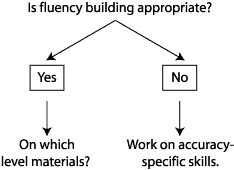Fluency

Teaching Strategies and Examples: Oral Reading Fluency
Step 1: Is Fluency Building Appropriate?
- Examine student's performance on the oral reading fluency measure to determine whether accuracy is an appropriate target.
- Identify target goal (e.g., 60 wcpm by end of grade 1; 90 wcpm by end of grade 2).
- Review the following performance patterns.
- Example A: 30 words attempted, 28 wcpm.
- Example B: 27 words attempted, 20 wcpm.
- Example C: 86 words attempted, 85 wcpm.

Step 2: How to Develop Oral Word Reading Fluency: Mediated Scaffolding and Review
- Identify passages students can read with 90-95% accuracy.
- Ensure that students can read 30-40 wcpm.
- Schedule repeated opportunities for the reader to hear and/or practice the passages.
- Aim to reduce the time and number of errors.
- Incorporate reading with expression once students can read 60 wcpm.
- Gradually shift from oral to silent reading.
Oral Reading Fluency Critical Components:
The majority of activities involve:
- repeated reading of the same materials
- fixed-time or fixed-length activities
- goal setting
- corrective feedback opportunities
- graphing/charting of learner performance
Repeated Readings Are:
- Not a replacement for beginning reading instruction.
- Not intended to constitute the reading curriculum.
- A short duration, frequently scheduled procedure to increase oral reading fluency.
(modified from Hasbrouck, 1998; see References)
Methods for Repeated Readings
- Fixed-time readings (1 minute) in which student reads the same text repeatedly (e.g., 3 times).
- Fixed-passage readings (e.g., 100 words) in which student calculates the time it takes to read the same 100 words on successive trials.
- Tape-recorded repeated readings.
- Peer review.
- Partner reading.
(modified from Hasbrouck, 1998; see References)
Sample Directions for Fixed-Time Repeated Reading
"Read this passage as quickly and carefully as you can. Try to remember as much of the passage as you can. If you get stuck on a word, skip it and I will help you when you finish. You will read for 1 minute. Get ready. Begin."
Guidelines for Pairing Students
It is not necessary for the higher ability readers to work with the students of greatest need. When pairing students, consider the following:
- Rank order students according to reading fluency.
- Split the rank ordered list in the top and bottom halves.
- Pair the top ranked students in the upper half with the top ranked student in the lower half (i.e., #1 with #13 if class has 26 students).
- Adjust pairings according to "personality" issues.
- Maintain pairs approximately four weeks.
(modified from Hasbrouck, 1998; see References)
Guidelines for Partner Reading Activities
- The higher performing partner reads first as a model.
- Use the materials of the lower performing reader.
- Allow both students opportunity to tutor (e.g., coach, teacher).
- Conclude the activity with a comprehension task (summarize main ideas, retell, answer questions).
Set Ambitious Goals
- Identify starting words correct per minute (e.g., 30 wcpm).
- Identify end of year grade level target (e.g., 90 wcpm by end of grade 2).
- Subtract current wcpm from target & determine whether this is a realistic target (i.e., 60 wcpm is highly ambitious).
- Set goals and define weekly learning targets (i.e., amount of growth/number of instructional weeks).
- Monitor progress over time.